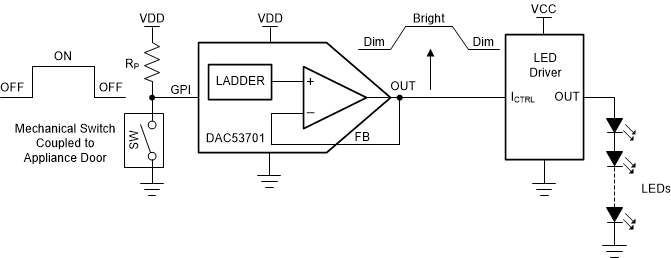SLASEY5 December 2020 DAC43701 , DAC53701
PRODUCTION DATA
- 1 Features
- 2 Applications
- 3 Description
- 4 Revision History
- 5 Device Comparison Table
- 6 Pin Configuration and Functions
-
7 Specifications
- 7.1 Absolute Maximum Ratings
- 7.2 ESD Ratings
- 7.3 Recommended Operating Conditions
- 7.4 Thermal Information
- 7.5 Electrical Characteristics
- 7.6 Timing Requirements: I2C Standard Mode
- 7.7 Timing Requirements: I2C Fast Mode
- 7.8 Timing Requirements: I2C Fast Mode Plus
- 7.9 Timing Requirements: GPI
- 7.10 Timing Diagram
- 7.11 Typical Characteristics: VDD = 5.5 V (Reference = VDD) or VDD = 5 V (Internal Reference)
- 7.12 Typical Characteristics: VDD = 1.8 V (Reference = VDD) or VDD = 2 V (Internal Reference)
- 7.13 Typical Characteristics
-
8 Detailed Description
- 8.1 Overview
- 8.2 Functional Block Diagram
- 8.3 Feature Description
- 8.4 Device Functional Modes
- 8.5 Programming
- 8.6
Register Map
- 8.6.1 STATUS Register (address = D0h) [reset = 000Ch or 0014h]
- 8.6.2 GENERAL_CONFIG Register (address = D1h) [reset = 01F0h]
- 8.6.3 CONFIG2 Register (address = D2h) [reset = 0000h]
- 8.6.4 TRIGGER Register (address = D3h) [reset = 0008h]
- 8.6.5 DAC_DATA Register (address = 21h) [reset = 0000h]
- 8.6.6 DAC_MARGIN_HIGH Register (address = 25h) [reset = 0000h]
- 8.6.7 DAC_MARGIN_LOW Register (address = 26h) [reset = 0000h]
- 8.6.8 PMBUS_OPERATION Register (address = 01h) [reset = 0000h]
- 8.6.9 PMBUS_STATUS_BYTE Register (address = 78h) [reset = 0000h]
- 8.6.10 PMBUS_VERSION Register (address = 98h) [reset = 2200h]
- 9 Application and Implementation
- 10Power Supply Recommendations
- 11Layout
- 12Device and Documentation Support
- 13Mechanical, Packaging, and Orderable Information
Package Options
Mechanical Data (Package|Pins)
- DSG|8
Thermal pad, mechanical data (Package|Pins)
- DSG|8
Orderable Information
9.2.1 Appliance Light Fade-In Fade-Out
Appliances such as toaster ovens, microwave ovens, refrigerators, cloth dryers, and more implement door lights for monitoring the status of the function. These door lights dim and brighten when the door closes and opens, respectively. Appliance manufacturers prefer to provide a smooth-dimming transition for a better user experience. However, a microcontroller is required for such an operation, and implementing a separate microcontroller and associated software is a big overhead. For this reason, only high-end appliances have such features. The DACx3701 provides a simpler way to control the slew of such lights without software. Figure 9-1 shows the simplified circuit diagram of light fade-in fade-out using MOSFET based control and Figure 9-2 shows the circuit with an external LED driver. For high-power LEDs, external LED drivers with headroom control are preferred over MOSFET-based LED control.
 Figure 9-1 Appliance Light Fade-In
Fade-Out
Figure 9-1 Appliance Light Fade-In
Fade-Out Figure 9-2 Fade-In Fade-Out with
Switching LED Driver
Figure 9-2 Fade-In Fade-Out with
Switching LED Driver